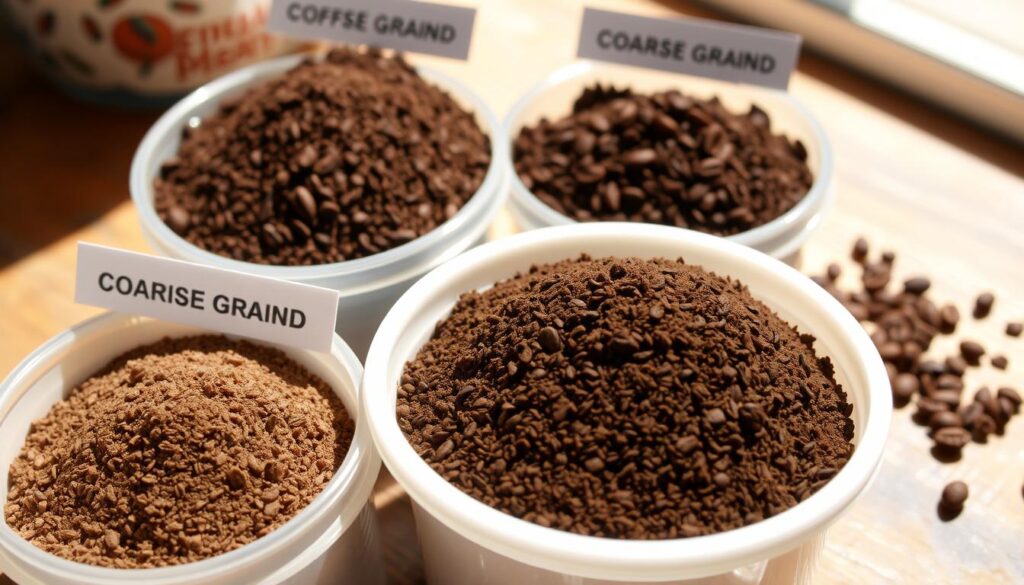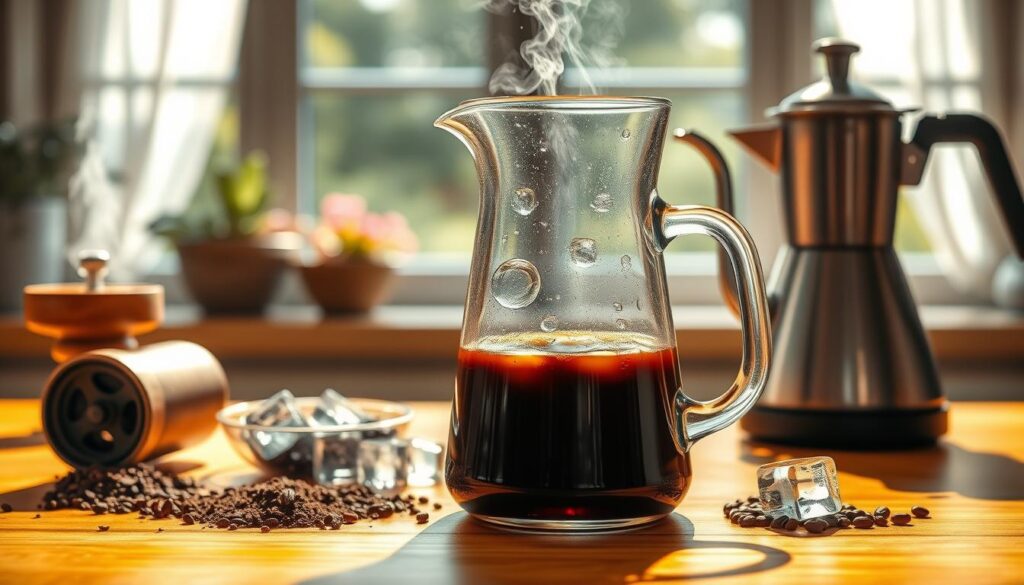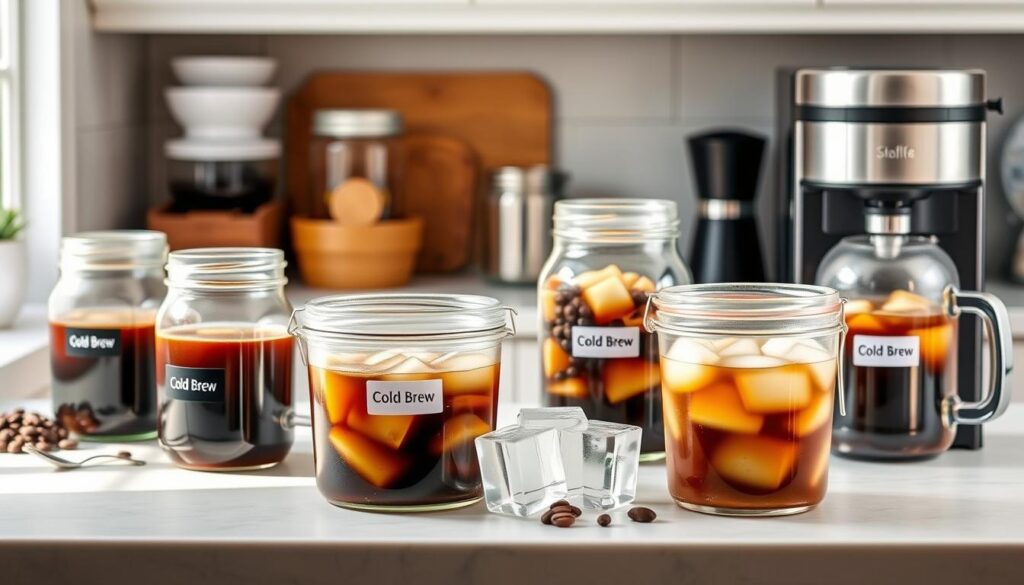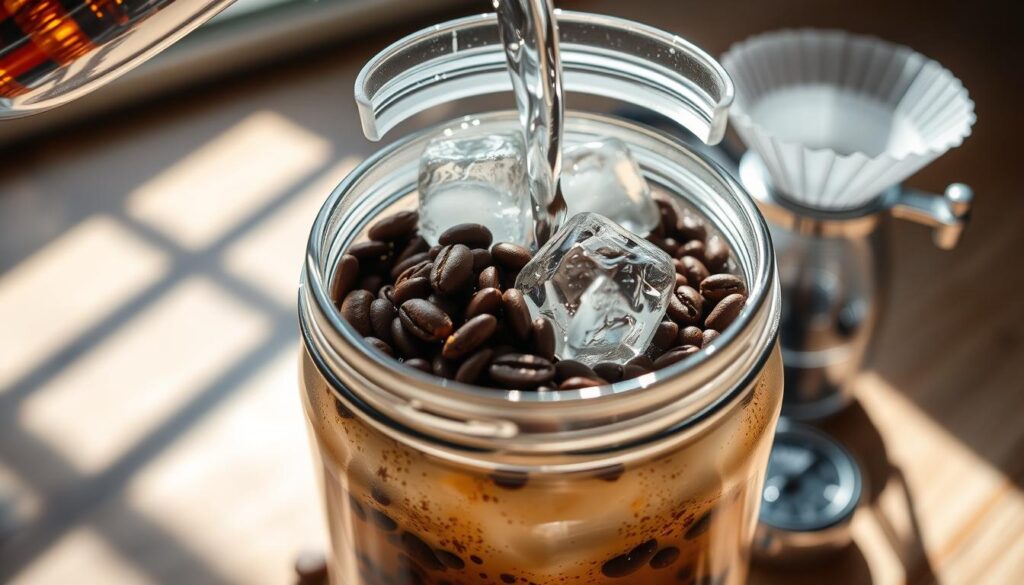Discover the secret to making the perfect cold brew coffee at home. Cold brew has become a favorite for its smooth, rich flavors. It’s different from hot-brewed coffee.
Making great cold brew coffee takes skill, patience, and knowledge of extraction science. Both pros and home brewers love it for its less acidic taste and deeper flavors.
Whether you love coffee or are just starting, learning the cold brew method can change your morning. It’s a refreshing twist on regular coffee.
Key Takeaways
- Cold brew creates smoother, less acidic coffee
- Proper technique is crucial for exceptional flavor
- Home brewing can rival professional coffee shops
- Extraction time significantly impacts taste profile
- Quality beans are essential for flavorful cold brew
Understanding Cold Brew Fundamentals
Cold brew coffee is a special way to make coffee. It changes the usual brewing process. This method dives into coffee chemistry in a new way.
The Science Behind Cold Extraction
Cold extraction is a careful process. It brings out coffee’s complex flavors without using heat. The chemical makeup of coffee beans changes a lot during this method:
- Lower temperature prevents bitter compound release
- Slower extraction reduces acid formation
- Gentle brewing preserves delicate flavor nuances
“Cold brew transforms coffee into a smooth, nuanced beverage that challenges traditional brewing expectations.” – Coffee Science Journal
Cold Brew vs Iced Coffee: Understanding the Difference
Many people mix up cold brew and iced coffee. But they are really different. Iced coffee is hot coffee cooled down, while cold brew is coffee steeped in cold water for a long time.
| Characteristic | Cold Brew | Iced Coffee |
|---|---|---|
| Brewing Temperature | Cold Water | Hot Water |
| Brewing Time | 12-24 Hours | Minutes |
| Acidity Level | Low | High |
Chemical Properties of Cold Brewing
The cold extraction method shows interesting coffee chemistry. It avoids high temperatures to keep certain compounds from forming. This makes the coffee smoother and more balanced, showing the true taste of the beans.
Selecting the Perfect Coffee Beans for Cold Brew
Choosing the right coffee beans is key to a great cold brew. You need to think about roast levels and flavor profiles. These should stand out with the cold brew method.
For cold brew, medium to dark roasts are best. They give a rich, chocolatey taste that’s perfect for cold brew.
“The secret to exceptional cold brew lies in selecting beans that harmonize with the slow extraction technique.”
Choosing between single-origin and blend beans is a matter of taste. Short-term rental fans know quality is crucial for great drinks.
- Single-Origin Beans: Show off unique regional tastes
- Blended Beans: Offer complex, balanced flavors
- Recommended Roast: Medium to dark roasts
For cold brew, aim for beans with natural sweetness and low acidity. Brazilian and Colombian beans are top choices. They add smooth, nutty flavors that shine in cold brew.
Essential Equipment for Cold Brew Success
Making the perfect cold brew is more than just coffee and water. The right tools can make all the difference. Choosing the right equipment is key to getting the smoothest, most flavorful cold brew.
Choosing the Right Coffee Grinders
Coffee grinders are vital for cold brew. Burr grinders are the best choice, offering consistent grinds for better extraction. When picking a grinder, think about these important points:
- Grind consistency
- Adjustable settings
- Durability
- Noise level
Advanced Filtration Methods
Good filtration is key for clear cold brew. Different systems can greatly affect taste and clarity. Professional baristas suggest using multiple stages to filter out sediment for a smoother drink.
Optimal Storage Solutions
Storing cold brew right is important to keep its quality. Use airtight glass containers or special pitchers to keep the flavor fresh. Look for containers with these features:
- UV-protected material
- Airtight seal
- Easy-pour design
- Capacity for multiple servings
“The right equipment turns cold brew from a simple drink into a crafted experience.” – Coffee Brewing Experts
Quality cold brew equipment might seem pricey, but it’s worth it. It ensures your homemade cold brew is as good as the ones from coffee shops.
The Ideal Grind Size for Cold Brew Coffee

Creating the perfect cold brew coffee begins with the right grind size. The right grind can make your brewing experience amazing. Cold brew brewing is different from other methods.
A coarse grind is key for cold brew. It’s like the texture of raw sugar or sea salt. This grind size helps extract flavors well without bitterness or too much strength.
“The difference between good and great cold brew lies in the consistency of your grind.” – Coffee Brewing Experts
- Coarse grind prevents over-extraction
- Consistent grind ensures uniform flavor profile
- Larger particle size promotes smooth brewing
Choose a grinder that makes consistent grinds. Burr grinders are better than blade grinders for coarse textures needed for cold brew.
Try different grinder settings to find your ideal grind. Start with a coarse grind and adjust as needed. Cold brew is forgiving, so small changes won’t ruin your coffee.
Water Quality and Temperature Guidelines
Making the perfect cold brew starts with knowing how important water quality is. The liquid base of your coffee can either make or break the brewing process. Water is more than just an ingredient; it’s the canvas for your coffee’s flavor.
Professional baristas understand that water quality for coffee is key. The right water can turn a simple brew into a unique taste experience.
Mineral Content Impact
Water’s mineral content greatly affects cold brew flavor. Different minerals can either boost or lower the coffee’s natural taste:
- Magnesium helps extract complex flavor compounds
- Calcium adds brightness and clarity
- Low mineral content can make coffee taste flat
Temperature Control Tips
Choosing the right temperature for cold brew water is crucial. Unlike traditional brewing, cold brew works best with cooler water:
- Use room temperature filtered water
- Target 40-70 degrees Fahrenheit
- Stay away from very cold or hot water
Filtering Options
Picking the right filtered water can make your cold brew stand out. Here are some filtering options to consider:
- Activated carbon filters remove chlorine
- Reverse osmosis systems offer clean water
- Mineral-balanced water improves coffee extraction
“Great coffee is 98% water – choose wisely.” – Coffee Brewing Experts
Pro tip: Try different water sources to find your ideal cold brew.
The Secret to Smooth and Flavorful Cold Brew

Making the perfect smooth cold brew is more than just mixing coffee and water. Baristas know it takes precision and understanding of cold brew techniques to make flavorful coffee.
“Great cold brew is an art form that balances science and creativity” – Coffee Brewing Expert
There are a few key things to get right for a silky smooth cold brew:
- Choose high-quality, freshly roasted coffee beans
- Use the right water-to-coffee ratio
- Control the steeping time and temperature
- Use effective filtration methods
Cold brew techniques are different from hot brewing. The slow extraction at lower temperatures makes the flavor smoother and less bitter.
| Technique | Impact on Flavor | Recommended Approach |
|---|---|---|
| Grind Size | Coarse grounds prevent over-extraction | Medium to coarse ground coffee |
| Steeping Time | Longer steeps enhance flavor complexity | 12-24 hours at room temperature |
| Filtration | Removes sediment for smooth texture | Multiple stage filtration |
Try different variables to find your perfect smooth cold brew technique.
Mastering the Coffee-to-Water Ratio
Making the perfect cold brew needs careful attention to the coffee-to-water ratio. The right mix turns a simple drink into a rich, smooth treat. Knowing how to balance coffee concentration is crucial for a great cold brew.
Cold brew fans know that how you dilute it matters a lot. The usual ratio is between 1:4 and 1:8, depending on how strong you like it.
- Mild Concentration: 1:8 ratio (less coffee, more water)
- Standard Concentration: 1:5 ratio (balanced flavor)
- Strong Concentrate: 1:4 ratio (intense coffee experience)
“The secret to great cold brew is finding your personal sweet spot between water and coffee grounds.” – Professional Barista
Start with a coffee concentration that lets you adjust it later. Most people like to make a strong batch. Then, they can add water, milk, or ice to get it just right.
Try out different ratios to find your favorite cold brew. Remember, the type of coffee bean, roast level, and grind size all affect the taste. You’re aiming for a smooth, flavorful drink that’s just right for you.
Steeping Time: Finding the Sweet Spot
Getting the perfect flavor from cold brew coffee takes patience and precision. It’s all about unlocking that rich, smooth taste that coffee lovers adore.

Short vs Long Steeping: Flavor Development Strategies
The time you steep your cold brew greatly affects the taste. Here’s how different times can change the flavor:
- Short Steeping (12-14 hours): This makes a lighter coffee with softer flavors.
- Long Steeping (18-24 hours): It brings out deeper, richer flavors.
Temperature Effects During Steeping
Temperature is key in extracting coffee flavors. Cold brewing needs cool temperatures to avoid bitterness. The best temperatures are between 35-40°F. This keeps the flavor smooth and avoids harsh acidity.
Taste Testing Guidelines
“The perfect cold brew is a personal journey of flavor discovery.” – Coffee Expert
To find your perfect steeping time, try these tips:
- Begin with a 16-hour steep as a starting point.
- Try the brew at different times.
- Write down your thoughts on the flavor.
- Change the steeping time based on what you like.
Remember, the best steeping time is what you prefer and the flavor you want.
Filtration Methods for Crystal Clear Results
To get a sediment-free coffee, you need to learn about cold brew filtration. The right coffee filters can make your cold brew smooth and silky. This ensures your coffee tastes professional every time.
There are many ways to filter cold brew, each with its own benefits. Knowing these methods helps you remove unwanted particles and get the best flavor.
- Paper Filters: Thin and disposable, capturing fine sediment
- Cloth Filters: Reusable and great for capturing medium-sized particles
- Metal Mesh Filters: Durable with larger pore sizes
- Ceramic Filters: Premium option for ultra-smooth results
When picking coffee filters, think about the mesh size and material. Smaller mesh filters make your coffee clearer but might take longer to filter.
| Filter Type | Sediment Removal | Flavor Preservation |
|---|---|---|
| Paper Filters | Excellent | Good |
| Cloth Filters | Very Good | Excellent |
| Metal Mesh | Fair | Very Good |
“The secret to perfect cold brew is not just in the beans, but in the filtration.” – Coffee Brewing Expert
Try out different cold brew filtration methods to find your favorite. This way, you can make coffee that’s clear and full of flavor.
Storage and Shelf Life Best Practices
Keeping cold brew coffee fresh and flavorful is key. It needs special storage care. Unlike regular coffee, cold brew needs specific methods to stay fresh and tasty.

Container Selection for Maximum Freshness
Choosing the right container is vital for keeping coffee fresh. Glass and stainless steel are best. They keep the coffee’s taste pure and prevent contamination.
- Use airtight containers with secure lids
- Select non-reactive materials like glass or stainless steel
- Avoid plastic containers that can absorb odors
Temperature Management Strategies
Keeping cold brew at the right temperature is crucial. It helps keep the coffee fresh for longer.
| Storage Location | Temperature Range | Expected Shelf Life |
|---|---|---|
| Refrigerator | 35-40°F | 7-10 days |
| Room Temperature | 68-72°F | 12-24 hours |
Preservation Techniques
Here are some ways to keep your coffee fresh:
- Store cold brew in a sealed container
- Keep away from direct light
- Always refrigerate after brewing
- Consume within one week for best taste
“The key to exceptional cold brew is not just in brewing, but in careful storage and preservation.” – Coffee Craft Experts
Follow these tips for cold brew storage. Your coffee will stay smooth, flavorful, and refreshing from start to finish.
Creative Cold Brew Recipes and Variations
Take your cold brew to the next level with new recipes. These drinks turn regular coffee into something amazing. They are smooth, rich, and perfect for exploring new flavors.
Discover these exciting cold brew flavors that are more than just coffee:
- Vanilla Lavender Cold Brew: Mix in lavender and vanilla syrup for a fancy twist
- Spiced Caramel Cold Brew: Add cinnamon and caramel for a cozy, sweet taste
- Coconut Mocha Cold Brew: Blend with coconut milk and chocolate for a tropical flavor
Coffee cocktails add a fun twist for cold brew lovers. Try these fancy drinks:
- Espresso Martini: Mix cold brew, vodka, and coffee liqueur
- Cold Brew Old Fashioned: Combine cold brew, bourbon, and bitters
- Irish Coffee Remix: Blend cold brew, Irish whiskey, and cream
“Cold brew is not just a drink, it’s a canvas for culinary creativity.” – Coffee Artisan
With these creative recipes, your home brewing becomes a gourmet adventure. It’s sure to impress and delight.
Conclusion
Making the perfect homemade cold brew is like an art. It mixes science, skill, and your own touch. By learning about brewing basics, like choosing beans and water quality, you can make your coffee better. Cold brew is about finding your own taste, not just following rules.
Every step in making cold brew is a chance to try new things. Pick the best beans, control the grind, and adjust steeping times. This way, you get smooth, rich flavors that hot coffee can’t match. The tips in this guide will help you start your cold brew adventure.
Being patient and precise is key to great cold brew. Begin with the basics, keep track of your steps, and feel free to tweak things. Your perfect cold brew will come from practice and a desire to learn. It’s a great way to enjoy a refreshing drink that’s just right for you.
Now you have the knowledge to make your home brewing better. Dive into the world of cold brew, be bold in your experiments, and enjoy the tasty outcomes of your new skills.
FAQ
What makes cold brew different from regular iced coffee?
Cold brew is made by steeping coarse ground coffee in cold water for 12-24 hours. This makes it smoother and less acidic than traditional iced coffee. Traditional iced coffee is hot coffee poured over ice.
What type of coffee beans work best for cold brew?
Medium to dark roast single-origin or blend coffees are best for cold brew. Look for beans with rich, chocolatey, or nutty flavors. These can handle the long extraction process well.
How long can I store cold brew in the refrigerator?
You can store cold brew in an airtight container in the fridge for 7-10 days. It will stay fresh and flavorful.
What’s the ideal coffee-to-water ratio for cold brew?
A 1:4 or 1:5 coffee to water ratio is standard. It makes a strong concentrate. You can dilute it with water or milk to taste. Some like a 1:3 ratio for a stronger brew.
Do I need special equipment to make cold brew at home?
You don’t need special equipment. Basic items like a large jar, coarse ground coffee, filtered water, and a fine-mesh strainer or cheesecloth work well.
How coarse should I grind my coffee beans for cold brew?
Use a coarse grind, like sea salt texture. This prevents over-extraction and makes the cold brew smooth and less bitter.
Can I make cold brew with different types of coffee roasts?
Yes, you can try different roasts. But medium to dark roasts usually make the most flavorful cold brew. Light roasts might have a more subtle taste.
How can I reduce the acidity in my cold brew?
Cold brewing naturally reduces acidity. Use low-acid coffee beans and filtered water. Also, keep the steeping time right to minimize acidity.
What’s the best way to serve cold brew?
Serve it over ice or dilute it with water or milk to taste. You can also use it in coffee cocktails and recipes. Some like it straight or with a bit of sweetener.
Can I warm up cold brew coffee?
Absolutely! You can gently heat cold brew without losing its smooth flavor. Just warm it slowly to keep the delicate taste.
Share this post: on Twitter on Facebook

